Weather Almanac for March 2001
POINTING TO THE WIND

Before the invention of the barometer in 1643, only wind vanes or streamers aided farmers and others in predicting the weather. The weatherwise can often foretell weather changes by observing clouds and the way the wind blows. Nature likely gave humans the first clues for constructing weather gauges as farmers and shepherds watched trees sway in the wind. Thus, all other meteorological instruments are but infants when it comes to the first known meteorological instrument: the wind vane or, as some folks call it, the weathervane. There are indications in the ancient writings that the first practical wind vanes appeared in ancient Mesopotamia 3500 to 4000 years ago!
Research into the ancient cuneiform writings by the late J. Neumann of The Hebrew University in Israel, unearthed a text of "Fable of the Willow" which states: "They look at the weather vane for the direction of the wind..." Further text fragments and a bit of deduction indicate that the vane was likely made of wood and fashioned in the form of a bird.
 The next written record of wind vanes can be found in the Chinese writings of about the 2nd Century BCE where reference is made to threads or streamers used to indicate the direction, and likely strength of the wind. A century later, there are references to a bronze wind vane, again bird-shaped. The next written record of wind vanes can be found in the Chinese writings of about the 2nd Century BCE where reference is made to threads or streamers used to indicate the direction, and likely strength of the wind. A century later, there are references to a bronze wind vane, again bird-shaped.
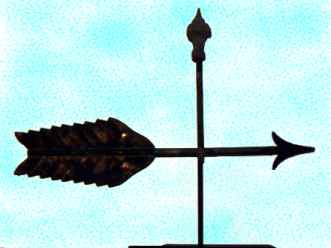 The wind vane, in contrast to the wind-banner style of wind indicator, consists of an asymmetrically shaped object, such as an arrow or rooster, mounted at its center of gravity so it can pivot freely about a vertical axis. Regardless of the design, the portion of the object with greater surface area (usually the vane tail) offers greater resistance to the wind and thus positions the vane so that the smaller portion points in the direction from which the wind is blowing. To be an accurate measure of the true regional wind direction, the wind vane must be mounted away from taller obstacles. As a rule of thumb, the distance from the nearest obstacle should be at least twice the height of that obstacle above the vane. The wind vane, in contrast to the wind-banner style of wind indicator, consists of an asymmetrically shaped object, such as an arrow or rooster, mounted at its center of gravity so it can pivot freely about a vertical axis. Regardless of the design, the portion of the object with greater surface area (usually the vane tail) offers greater resistance to the wind and thus positions the vane so that the smaller portion points in the direction from which the wind is blowing. To be an accurate measure of the true regional wind direction, the wind vane must be mounted away from taller obstacles. As a rule of thumb, the distance from the nearest obstacle should be at least twice the height of that obstacle above the vane.
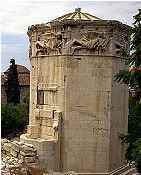 Many historians of the wind vane cite as the first weather vane the one topping the Athenian Tower of the Winds built in 48 BCE by the Greek astronomer Andronicus of Kyrrhos. To give the tower character, he adorned the peak with a rod and a huge bronze figure. The figure, which is believed to have been 1.2 to 2.4 m (4 to 8 ft) long, depicted Triton, the demi-god of the sea who had the head and torso of a man and the tail of a fish. The vane turned in the wind like a modern mobile with Triton's finger pointing in the direction of the wind. The octagonal tower had on each face one of the Greek wind deities, and the direction and deity to which Triton pointed signified the controlling deity and thus the weather to be expected. Many historians of the wind vane cite as the first weather vane the one topping the Athenian Tower of the Winds built in 48 BCE by the Greek astronomer Andronicus of Kyrrhos. To give the tower character, he adorned the peak with a rod and a huge bronze figure. The figure, which is believed to have been 1.2 to 2.4 m (4 to 8 ft) long, depicted Triton, the demi-god of the sea who had the head and torso of a man and the tail of a fish. The vane turned in the wind like a modern mobile with Triton's finger pointing in the direction of the wind. The octagonal tower had on each face one of the Greek wind deities, and the direction and deity to which Triton pointed signified the controlling deity and thus the weather to be expected.
If Andronicus placed such a large vane on his tower, it is likely that the wind vane had been in use in Greece for some time. To the ancients, the winds had divine powers, and the Greeks displayed public notices in many cities to inform the populus of the wind direction. Aristotle in his book Meteorologica (~ 330 BCE) and Theophrastus in De Ventis (~ 300 BCE) both understood that the direction of the wind played a part in determining the weather character.
The Triton vane atop the Tower does appear to be the first known attempt to make the wind vane more than just an indicator of the wind. It set a style for decorating buildings with an esthetically pleasing object -- in this case, the wind vane -- that was to highlight Greek and Roman architecture during the period. In Greece and Rome, weather vanes depicting the gods Boreas, Aeolus, Hermes and Mercury decorated the villas of many wealthy landowners.
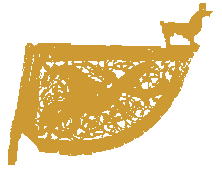 Archaeologists have unearthed bronze Viking weather vanes from the 9th Century. These vanes had an unusual quadrant shape, usually surmounted by an animal or creature from Norse mythology. They were common on Viking ships, and were also popular on Scandinavian buildings and churches. Many weather vanes in this early style can be seen today in Sweden and Norway. Archaeologists have unearthed bronze Viking weather vanes from the 9th Century. These vanes had an unusual quadrant shape, usually surmounted by an animal or creature from Norse mythology. They were common on Viking ships, and were also popular on Scandinavian buildings and churches. Many weather vanes in this early style can be seen today in Sweden and Norway.
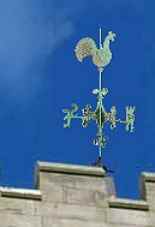 In the 9th Century AD, the Pope reportedly decreed that every church in Europe should prominently display a cock on its dome or steeple as a reminder of Jesus' prophecy that the cock would not crow the morning after the Last Supper, until the disciple Peter had denounced Him three times (Luke 22:34). Originally these cocks were just static figures but eventually they evolved into rooster-shaped wind vanes. It is not known exactly when these church steeple roosters were converted to weathercocks or vanes, but mention of cocks turning with the wind in Chaucer's works suggest that this had occurred by at least the thirteenth or fourteenth century in England. (Curiously, Roman Catholic churches are no longer capped by weathercocks, and the ecclesiastical roosters found today generally top Protestant churches, both in Europe and America.) In the 9th Century AD, the Pope reportedly decreed that every church in Europe should prominently display a cock on its dome or steeple as a reminder of Jesus' prophecy that the cock would not crow the morning after the Last Supper, until the disciple Peter had denounced Him three times (Luke 22:34). Originally these cocks were just static figures but eventually they evolved into rooster-shaped wind vanes. It is not known exactly when these church steeple roosters were converted to weathercocks or vanes, but mention of cocks turning with the wind in Chaucer's works suggest that this had occurred by at least the thirteenth or fourteenth century in England. (Curiously, Roman Catholic churches are no longer capped by weathercocks, and the ecclesiastical roosters found today generally top Protestant churches, both in Europe and America.)
Logic would suggest that the roosters became weathervanes very quickly because of the eminence of their position on top of the tallest structure in every town. This made it possible to observe the vane without difficulty and from a great distance on a clear day. Weathervanes aided farmers and others in keeping a lookout for changing weather. The weatherwise can often foretell major weather changes simply by observing clouds and the strength and direction that the wind blows. For example, east winds with lowering clouds often herald rain; northwest winds, fair but colder weather. This use of wind vanes to aid in early weather forecasting likely gave birth to their alternate name of weathervane.
The banners which flew from medieval towers in Britain, Normandy and Germany are probably precursors to our modern weather vanes. The modern English word "vane" actually comes from the Anglo-Saxon word "fane", meaning "flag". Originally, fabric pennants were placed around the castle towers to show its archers the direction of the wind. Later, the cloth flags were replaced by metal ones, often decorated with the insignia or coat of arms of the lord or nobleman, and balanced to turn in the wind.

While the medieval nobility were permitted to display and carry their coat of arms on a square banner, lesser ranks were only allowed pennants with single or double tails. This elongated, trailing pennant was called a banneret, and its form became the prototype for a style of wind vane still common today, known as the windsock. The long, graceful lines of the banneret also lent themselves admirably to other weathervane designs. Banneret weathervanes were common during the Gothic revival period in the United States during the 19th Century.
Weathervanes flourished with the settling of the New World, particularly in what was to become Canada and the United States. The likely reason was the need to be informed of the often rapid and destructive weather changes experienced by farmers and sailors on the North American continent. And not only did they have practical use, but they become a favorite expression of folk art in the rural regions.
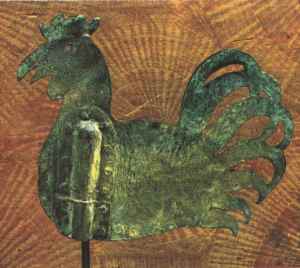 In North America, the better-made, early weathervanes, including the few remaining examples of vanes dating from the 17th Century, were made abroad and imported by the early settlers. The oldest record of a vane in America is the weathercock made in Holland in 1656 which topped the Dutch Reformed Church in Albany, New York. This weathercock is still in use and can be viewed on a peak between the twin spires of the First Church in Albany. In North America, the better-made, early weathervanes, including the few remaining examples of vanes dating from the 17th Century, were made abroad and imported by the early settlers. The oldest record of a vane in America is the weathercock made in Holland in 1656 which topped the Dutch Reformed Church in Albany, New York. This weathercock is still in use and can be viewed on a peak between the twin spires of the First Church in Albany.
Among other colonial American vanes still in existence is a banner with the date 1673 cut into it. This banner is now in the collection of the Concord, Massachusetts Free Library.

America's first documented weathervane maker, Deacon Shem Drowne, created the famous grasshopper vane atop Boston's Faneuil Hall (1742), as well as the banner for Boston's Old North Church (1740). A rooster now found on First Church in Cambridge (1721), and a large copper Indian built for Boston's Province House (1716) were both Drowne creations. The Faneuil Hall vane was made from copper and gold and has a green glass eye. It is balanced so that its head and antennae point into the wind.
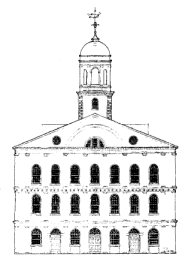 A similar grasshopper weathervane sat atop the London Exchange in England in the mid-18th Century. Peter Faneuil had been a member of the London Exchange and ordered a grasshopper vane to decorate his Hall in Boston to symbolize his hopes that Boston would becoming the financial center of the New World. The vane is the only remaining original portion of Faneuil Hall on the current structure, but its life has not been without mishap. It dismounted its perch during an earthquake in 1755; fell free during the building's destruction by fire in 1761; and survived a "grasshopper napping" in the early 1970s. A similar grasshopper weathervane sat atop the London Exchange in England in the mid-18th Century. Peter Faneuil had been a member of the London Exchange and ordered a grasshopper vane to decorate his Hall in Boston to symbolize his hopes that Boston would becoming the financial center of the New World. The vane is the only remaining original portion of Faneuil Hall on the current structure, but its life has not been without mishap. It dismounted its perch during an earthquake in 1755; fell free during the building's destruction by fire in 1761; and survived a "grasshopper napping" in the early 1970s.
Wind vanes were popular with America's Founding Fathers and early Presidents. A wooden codfish vane originally studded with copper nails to appear as scales once topped Paul Revere's shop and is now on exhibit at the Paul Revere House in Boston. George Washington in 1787 commemorated the end of the Revolutionary War by commissioning Joseph Rakestraw to design a "Dove of Peace" weather vane for his estate at Mount Vernon. Thomas Jefferson attached his weather vane on Monticello to a pointer in the ceiling of the room directly below, so he could read the direction of the wind from inside his home.
The making of less sophisticated, utilitarian wind vanes flourished in early rural America. Dependent upon the knowledge of which way the wind was blowing and living too far from the church or town hall to see those vanes, most farmers made their 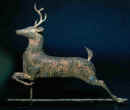 own or hired the local blacksmith to construct one for them. In addition to the traditional rooster, arrow, or banner weathervanes, they began fashioning vanes after subjects that were part of their everyday lives. During the latter half of the 18th Century vanes representing native America themes, horses, wild animals, and angels turned with the wind atop farm buildings and on village halls and churches. Along the seacoast, vanes expressed concerns for nautical matters using as motifs sailing ships, fish and sea gulls. After the US Revolutionary War, many Americans favored patriotic themes for their weather vanes, including the Goddess of Liberty, likenesses of George Washington and of course, the Federal Eagle. own or hired the local blacksmith to construct one for them. In addition to the traditional rooster, arrow, or banner weathervanes, they began fashioning vanes after subjects that were part of their everyday lives. During the latter half of the 18th Century vanes representing native America themes, horses, wild animals, and angels turned with the wind atop farm buildings and on village halls and churches. Along the seacoast, vanes expressed concerns for nautical matters using as motifs sailing ships, fish and sea gulls. After the US Revolutionary War, many Americans favored patriotic themes for their weather vanes, including the Goddess of Liberty, likenesses of George Washington and of course, the Federal Eagle.
Weather vanes come in many styles and body shapes. Most common forms are:
ARROWS: A basic arrow style is just that, a point and "feathers" (known as the fletching) attached to a horizontal tube.
BANNERS and BANNERETS: Style derived from pennants and flags, the basic parts are a point in front and a flat area in back.
SILHOUETTES: This style is, on its basic level, a two-dimensional representation of an object, but can be varied in complexity with layering and many types of artistic metal- and woodworking techniques. Many farmers would carve a piece of wood into a simple silhouette figure for use on their barns.
 |  | 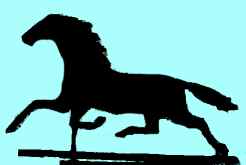 |
| ARROWS | BANNERS
and BANNERETS | SILHOUETTES |
SWELL-BODIED: A three-dimensional form of wind vane, most closely associated with the heyday of American weather vane makers. Molds are created and sheet copper is hammered into the mold. The two pieces are then trimmed and soldered together to produce a hollow form thicker in width than the flat silhouette style.
FULL-BODIED: This style is a truly 3-dimensional representation of the subject, more detailed than the swell-bodied vanes.
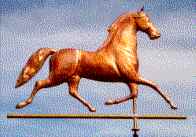 |  |
| FULL-BODIED | SWELL-BODIED |
While many wind vanes, or weathervanes, were erected for practical use, from the early 1800s to the present, their placement on private and public buildings again became an expression of local art. Vanes of famous racing horses like "Black Hawk" were modeled after popular Currier and Ives prints. In the latter half of the nineteenth century, eagles carved from wood, hammered out of copper, or cut from iron turned with the wind atop public buildings, flagpoles, and houses.
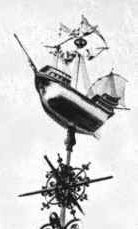
Ornamental weathervanes produced during the latter half of the 19th Century were made by specialist manufacturers and often represented the many factors that led to the rapid growth of the United States during that period: the great railroad expansion, the development of new and elaborate fire-fighting equipment, the development of industry, the age of farm specialization, and the country's interest in exotic animals of other lands. Victorian buildings had fancy weather vanes and elaborate metalwork embellishing almost every inch of roof space. The latter half of the 19th Century has been considered by many as the golden age of weathervanes.
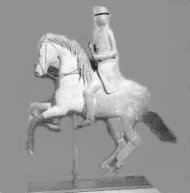 Today, building weathervanes are more decoration than instrument, but a renewed interest in this folk art has spawned a market for antique weathervanes. Although you can buy one for $20 or less, recent prices for antique vanes has literally spun sky high. In April 1982, a rare Statue of Liberty weather vane, molded from gilded copper a century ago, was sold by Sotheby's for $82,500. The same day, an Angel Gabriel weather vane sold for $50,600. During a 1995 fund raiser for The Museum of American Folk Art, two antique wind vanes sold for between $100,000 and $150,000. Today, building weathervanes are more decoration than instrument, but a renewed interest in this folk art has spawned a market for antique weathervanes. Although you can buy one for $20 or less, recent prices for antique vanes has literally spun sky high. In April 1982, a rare Statue of Liberty weather vane, molded from gilded copper a century ago, was sold by Sotheby's for $82,500. The same day, an Angel Gabriel weather vane sold for $50,600. During a 1995 fund raiser for The Museum of American Folk Art, two antique wind vanes sold for between $100,000 and $150,000.
The all-time record to date for a weather vane is $770,000 for a horse and rider weather vane (a larger version of one sold at the aforementioned Museum auction seen above at left) from the Barenholtz collection that sold at Sotheby's in New York City on January 27, 1990.
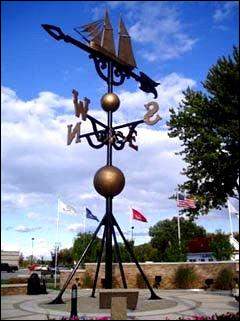 Update: Montague, a picturesque community in Muskegon County, Michigan, claims to be the home of the world's largest wind vane. "Until someone proves it's not the largest," proclaimed Amy VanLoon, executive director of the White Lake Area Chamber of Commerce, "we're saying it is." The vane measures 48 feet tall, 14 feet wide, and weighs more than 2 tons. Montague is also home to Whitehall Products which makes weather vanes including this vane which they donated to the community in 1984. The vane's figure is the schooner, Ella Ellenwood, owned and operated by the Flagstad family of Montague in the 1800s. In 1901, the schooner broke up and sunk in a storm on Lake Michigan, but the nameplate floated back to White Lake the next year. The vane resides in Ellenwood Park on the White Lake shore. (photo courtesy the City of Montague) Update: Montague, a picturesque community in Muskegon County, Michigan, claims to be the home of the world's largest wind vane. "Until someone proves it's not the largest," proclaimed Amy VanLoon, executive director of the White Lake Area Chamber of Commerce, "we're saying it is." The vane measures 48 feet tall, 14 feet wide, and weighs more than 2 tons. Montague is also home to Whitehall Products which makes weather vanes including this vane which they donated to the community in 1984. The vane's figure is the schooner, Ella Ellenwood, owned and operated by the Flagstad family of Montague in the 1800s. In 1901, the schooner broke up and sunk in a storm on Lake Michigan, but the nameplate floated back to White Lake the next year. The vane resides in Ellenwood Park on the White Lake shore. (photo courtesy the City of Montague)
Learn More From These Relevant Books
Chosen by The Weather Doctor
- Huler, Scott: Defining the Wind: the Beaufort Scale, and How a 19th-Century Admiral Turned Science Into Poetry, 2004, Crown Publishers, ISBN 1400048842 HC, 304 pages.
- Deblieu, Jan: Wind : How the Flow of Air has Shaped Life, Myth, and the Land, 1998, Houghton Mifflin Company, ISBN 0-395-78033-0.
 Written by Written by
Keith C. Heidorn, PhD, THE WEATHER DOCTOR,
March 1, 2001, updated July 11, 2009
The Weather Doctor's Weather Almanac
Pointing To The Wind
©2001, Keith C. Heidorn, PhD. All Rights Reserved.
Correspondence may be sent via email to: see@islandnet.com.
For More Weather Doctor articles, go to our Site Map.

I have recently added many of my lifetime collection of photographs and art works to an on-line shop where you can purchase notecards, posters, and greeting cards, etc. of my best images.

Home |
Welcome |
What's New |
Site Map |
Glossary |
Weather Doctor Amazon Store |
Book Store |
Accolades |
Email Us
|



|









